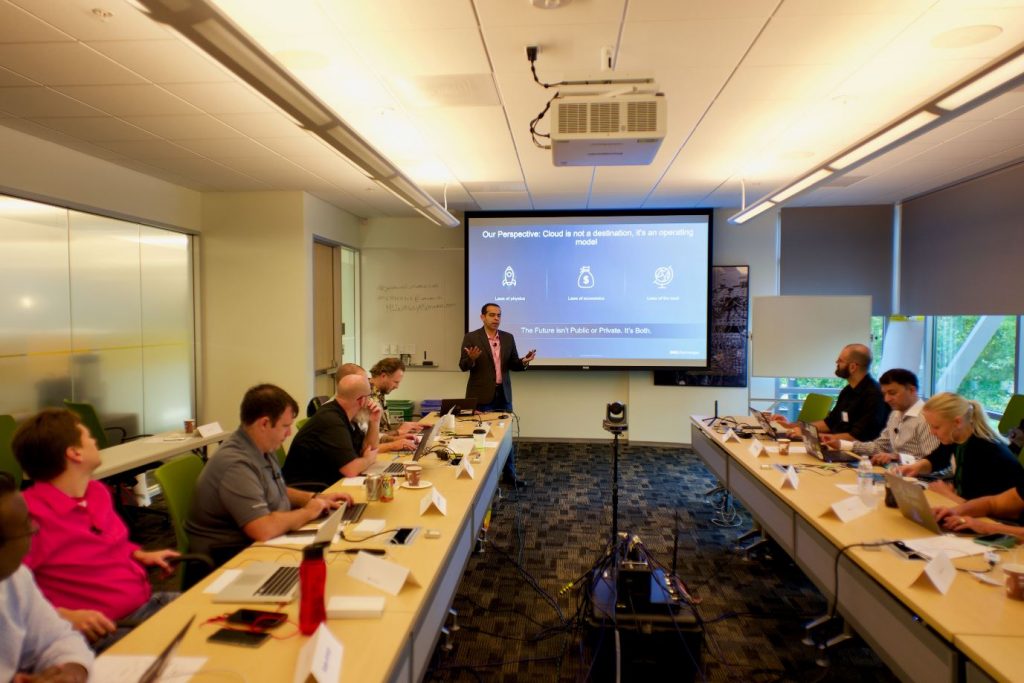 At this year’s Cloud Field Day, the range of beliefs and challenges around the cloud were on full display. For all the contrasting perspectives, two clear certainties emerged from the day. First, customers are putting more focus and investment on the cloud than ever before. And second, they are working hard to rationalize and manage their cloud deployments.
At this year’s Cloud Field Day, the range of beliefs and challenges around the cloud were on full display. For all the contrasting perspectives, two clear certainties emerged from the day. First, customers are putting more focus and investment on the cloud than ever before. And second, they are working hard to rationalize and manage their cloud deployments.
Cloud Field Day is a unique event in which IT vendors provide in-depth presentations on their technology and solutions with independent, influential practitioners and experts. Our presentation on Dell Technologies Cloud touched off a lively conversation.
The audience didn’t hesitate to grill us the on technical and business details of our solution. They asked the hard questions. This type of honest discussion is a critical part of better understanding the market.
Here is what stood out to me across the day’s presentations and discussions.
“Private cloud” vision is finally becoming a reality
Can the data center offer the same level of automation and simplicity as the cloud? Our sessions really centered in on that, and the delegates really popped on this idea. This is the key to making the elusive “private cloud” vision that the industry has been chasing for years a reality. Rick Reddy from the VxRail team walked through automated lifecycle management and the idea of delivering a “known good state” to organizations through Dell Technologies’ testing and validation of the software and firmware. This reduces much of the management overhead in a very similar way that the public cloud does this. The room seemed really interested in this topic and how it can lessen the burden on IT Operations. Unfortunately, there wasn’t enough time to do the demo I teased, but you can run through it yourself here.
Multi-cloud is forcing customers to confront complexity
The companies that also presented at CFD6 ranged from storage, networking, DevOps management platform, and network security monitoring vendors. While each perspective was unique, they all described the same problem: complexity as a result of operating in multiple clouds. Varun Chhabra, VP Dell Technologies Cloud, recently shared his view. This has been at the center of our consistent hybrid cloud strategy.
This is not a new phenomenon. We’ve continued to run through this cycle as emerging technologies become mature, often followed by a more or less unstructured proliferation of applications on that model, which can actually overwhelm it. We started with physical servers until the care and feeding of them was too much. Then VMware pioneered virtualization to abstract away the physical servers, but large organizations soon encountered VM sprawl. Automation and orchestration held the next breakthrough, followed quickly by cloud which took it a step further by introducing the idea of impermanence and self-service to applications. Now we are facing cloud sprawl. Does Virtualization hold the answer? That is what we’re betting on with Dell Technologies Cloud.
Consistency is the key
Be it with containers, virtualization multi-cloud SaaS software, or storage gateways, organizations are trying to make their data, applications, and management stacks portable and easier to run across multiple clouds. Obviously, with the investments we’re making in Dell Technologies Cloud, we’re betting on the Software-Defined Data Center as well as containers, which we recently announced, but there are many ways to solve these problems.
Experts in the room agreed that things get messy when you cross clouds. For example, many vendors have their own managed Kubernetes container management systems which won’t scale into other clouds. We are not immune to similar challenges. Sometimes it’s the way we have marketed products across different clouds, sometimes it’s small variances between the managed offerings like VMC on AWS or VMC on Dell, and the customer-owned and operated VMware Cloud Foundation variants. That being said we believe the ownership experience for customers will be much better than managing multiple clouds using native tools, or having to onboard extremely disruptive toolsets.
At the end of the day organizations are interested in one thing: it simply needs to work. An investment in VMware’s SDDC will absolutely make it easier to apply virtualization as an abstraction layer across clouds, as consistent infrastructure and operations will span these environments, but we left the room without getting to the answer of just how consistent that experience will be and how routine tasks and functions will work in this hybrid environment. This is a topic that we will be closely examining as we continue on our cloud journey.
We are just scratching the surface
It was great participating in such an exciting event and engaging with so many knowledgeable individuals. You wouldn’t think two hours would be enough time to brief an audience on a technology solution, that’s longer than many feature-length movies, but there was still a lot to cover by the end. That being said both, the validations as well as the critiques, provide the opportunity to continue iterating our product and message to better meet our customers’ needs and help organizations reduce the complexity of operating in multiple clouds. I’ll continue to watch and learn at future Cloud Field Days and look forward to our next opportunity to engage the delegates on our solution.
If you’re interested in learning more about these topics watch the replay of the event.
